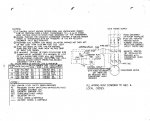I am really just digging into this for my own knowledge.
Customer of the company I work at wanted to hook up an old ingersoll rand air compressor. It is 20hp, 9 lead 230/460v motor, compressor head has 3 pistons I believe. It is basically in a shed, over 500 feet from their main disconnect, 400a 208v 3 phase overhead service. Their power that runs all their equipment (large junkyard) is fed from a 200a overhead feeder off that main, which someone before me tapped off of to feed this pig. Traditional across the line mag starter, btw. They were decent enough to install buck boost xfmrs.
It would start and satisfy the pressure switch no problem from empty, but starting under load was no good, tripping overload. Voltage drop was terrible, around 180 while starting. Not sure if this was before or after the boost transformers.
Boss had idea of installing a new overhead feeder, 4/0 aluminum ASCR, biggest available supposedly. This is where I got involved in the installation. We ran the overhead, and temporarily bugged it onto the beginning of the 200A feeder to see if it works before configuring a permanent feed. It did seem to work, though not perfect. Motor takes a good 4-5 seconds to get up to full speed, after which it runs pretty good, around 55-60a at 208v at the starter (after boost xfmr). But starting current is over 200a and takes what seems like forever to get under 100a. It is about 5 seconds though.
Seems rough on the equipment IMHO, even if it is used. This compressor will be used every day, full 10+ hour shifts with frequent starts. I was amprobing the feeder and counted 5 starts in about 15 minutes.
Would a soft start or part winding starter help at all? I know compressors are tough starting and the voltage drop doesn't help. I also am not the executive decision maker, but would like to hear some ideas to make this thing run reliably. Smaller pulley on motor side is first thing that came to my mind.
Customer of the company I work at wanted to hook up an old ingersoll rand air compressor. It is 20hp, 9 lead 230/460v motor, compressor head has 3 pistons I believe. It is basically in a shed, over 500 feet from their main disconnect, 400a 208v 3 phase overhead service. Their power that runs all their equipment (large junkyard) is fed from a 200a overhead feeder off that main, which someone before me tapped off of to feed this pig. Traditional across the line mag starter, btw. They were decent enough to install buck boost xfmrs.
It would start and satisfy the pressure switch no problem from empty, but starting under load was no good, tripping overload. Voltage drop was terrible, around 180 while starting. Not sure if this was before or after the boost transformers.
Boss had idea of installing a new overhead feeder, 4/0 aluminum ASCR, biggest available supposedly. This is where I got involved in the installation. We ran the overhead, and temporarily bugged it onto the beginning of the 200A feeder to see if it works before configuring a permanent feed. It did seem to work, though not perfect. Motor takes a good 4-5 seconds to get up to full speed, after which it runs pretty good, around 55-60a at 208v at the starter (after boost xfmr). But starting current is over 200a and takes what seems like forever to get under 100a. It is about 5 seconds though.
Seems rough on the equipment IMHO, even if it is used. This compressor will be used every day, full 10+ hour shifts with frequent starts. I was amprobing the feeder and counted 5 starts in about 15 minutes.
Would a soft start or part winding starter help at all? I know compressors are tough starting and the voltage drop doesn't help. I also am not the executive decision maker, but would like to hear some ideas to make this thing run reliably. Smaller pulley on motor side is first thing that came to my mind.



